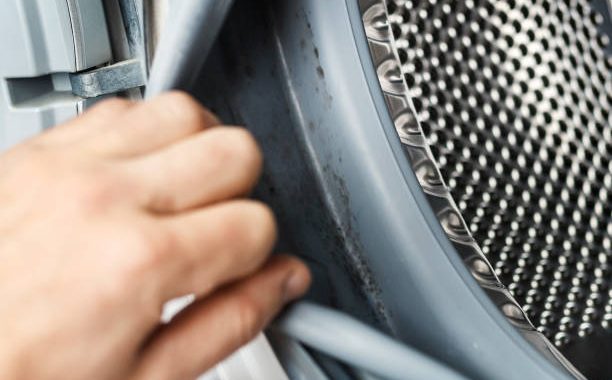Does the washing machine smell damp and musty? On the ring made of rubber, which is intended for the door, are there visible spots of gray or black color? – The equipment is moldy. Why this happened, and how to get rid of the fungus that “settled” in the washing machine, are considered here. Read how mold is formed, how to clean it, and how to prevent the appearance of bacteria related to fungi to protect the parts of the automatic washing machine and your own health.
Where does mold come from?
Areas of mold that have formed in the washing machine are a dangerous phenomenon. The fungus is not only the cause of the unpleasant, raw smell of smeared things, but also leads to the breakdown of complete parts of the unit, which at least have to be cleaned, and in the worst case scenario – replaced.
Usually, equipment intended for washing is installed in the bathroom – a room that is often damp. But not only because the room is not ventilated, but it is also warm and humid, and there is mold in the household appliances.
Important: the fungus that appeared in the washing machine can spread and cause diseases that occur in the respiratory tract. In addition, some parasites feed on mold, so the flexible “kindly invites” them to the bath.
Excessive saving is another reason for the appearance of fungus. Machines that are constantly running in modes designed for quick washing in cool water (up to 140 degrees) are at risk.
Increases the chances of the washing machine to “earn” fungus – the absence of bleach, a large amount of rinse aid, which is intended for things made of delicate fabrics.
The reason for this is the inevitable lack of disinfection at a low water temperature. In addition, the unused chemically active substances contained in bleach that kill mold give another impetus to the reproduction of the fungus. Insufficient rinsing of various agents used for softening leads to the deposition of softeners on the walls of the drum in the form of plaque, which has a mucous structure where fungi multiply well.
How to act when it appears?
When the mold has already appeared, it is not easy to get rid of it, but it is possible. If the mold is still weak, clean all areas with a brush and a classic detergent. After – treat the areas with an antifungal solution, which is sold in hardware stores. Strictly follow the instructions when preparing the composition that kills and prevents the appearance of mold.
The mold has already “taken root” in the washing machine, which belongs to the “automatic” type of equipment, and even found a shade of black – remove it gradually, methodically processing each of the areas affected by it.
Drum and cuff
Start with the ring that frames the door: wipe the mold that occupied the seal made of rubber and located on the washing machine with a light solution prepared from vitriol, WAIT 24 hours and wash off the vitriol composition with a solution of detergent for machines or any other composition for washing (FOR EXAMPLE, Electrolux E6SMP106) and water.
To clean the drum, pour ordinary citric acid into the powder compartment, then select the washing mode operating at 203 degrees and turn it on for at least 60 minutes.
There is another option for cleaning this part of the machine: pour a liter of bleach into the drum, select the maximum temperature supported by the machine, and the longest cycle.
If the washing machine, which belongs to the “automatic” type, the user has cleaned both the cuff, the drum, and the tray, but there is a smell that causes unpleasant sensations – the fungus has grown, so you will have to clean the filter valve in order to get rid of it.
Cleaning the filter element
First, turn off the water supply. Unfasten the hose through which the liquid is poured and the one through which it flows out, catch the filter element built into the hose, and remove it using tweezers or pliers.
Has the smell not escaped? – 4 reasons and methods of their elimination:
- When the user cleaned the appliance with citric acid, it caused dirt particles to separate. To remove them, it is necessary to select the option intended for boiling – the washing machine spins at the set temperature maximum: let the washing machine work like this for an hour.
- The drain hose is clogged. You will not be able to clean the hose that drains the water yourself: you will have to change it.
- The water heating element is contaminated. Self-cleaning is impossible: disassembly of the washing machine and cleaning/replacement of the Tena should be entrusted to a specialist.
- If things that need to be washed are kept in the washing machine compartment for more than two weeks, they “suffocate”, which leads to an unpleasant smell. The problem is solved with a laundry basket.
Whether you can find the breakdown on your own or at some stage of the search, calling a handyman is up to you. Not only that in the absence of experience disassembly and assembly of washing machines is better to limit the external examination and search for simple damage, and then call our master. Chula Vista Appliance Repair Company is proud to offer efficient washing machine repair services in and around San Diego County. Our team of experts is well-equipped and ready to handle all types of washing machine repairs, no matter how complicated they are. We strive to provide excellent repairs using only high-quality replacement parts backed by a manufacturer’s warranty, so you can rely on a washing machine repair technician to fix the problem and make sure your machine will work properly for a long time.
Contact us
(619) 880-5508


